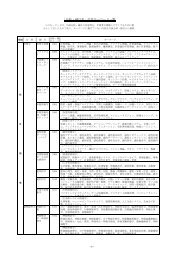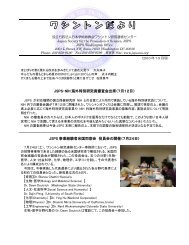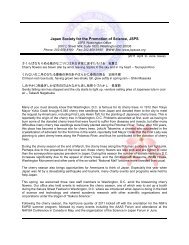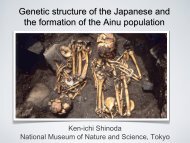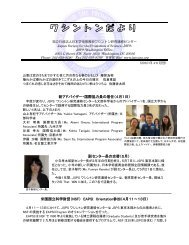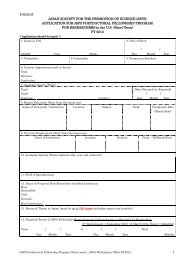Genetic structure of the Japanese and the formation of the Ainu ...
Genetic structure of the Japanese and the formation of the Ainu ...
Genetic structure of the Japanese and the formation of the Ainu ...
You also want an ePaper? Increase the reach of your titles
YUMPU automatically turns print PDFs into web optimized ePapers that Google loves.
<strong>Genetic</strong> <strong>structure</strong> <strong>of</strong> <strong>the</strong> <strong>Japanese</strong> <strong>and</strong><br />
<strong>the</strong> <strong>formation</strong> <strong>of</strong> <strong>the</strong> <strong>Ainu</strong> population<br />
Ken-ichi Shinoda<br />
National Museum <strong>of</strong> Nature <strong>and</strong> Science, Tokyo
nuclear genome 3 billion<br />
Mitochondrial DNA<br />
mitochondria<br />
Structures <strong>of</strong> mtDNA<br />
16,569 base pair
History <strong>of</strong> <strong>the</strong> analysis<br />
1980’s<br />
Analysis <strong>of</strong> <strong>the</strong> DNA digestion pattern with restriction<br />
enzymes.<br />
1990’s<br />
Analysis <strong>of</strong> sequence in a region <strong>of</strong> <strong>the</strong><br />
mitochondrial genome that undergoes frequent<br />
mutation.<br />
21th century<br />
Analysis <strong>of</strong> <strong>the</strong> complete DNA sequence <strong>of</strong><br />
mitochondrial genomes.
20,000 BP.-<br />
Human migration <strong>and</strong><br />
<strong>formation</strong> <strong>of</strong> mitochondrial DNA haplogroups<br />
D<br />
A<br />
X<br />
B C<br />
A D<br />
B C<br />
A D<br />
L2<br />
L3<br />
L1<br />
L2<br />
I<br />
L0<br />
L1<br />
L3<br />
60,000-20,000 BP.<br />
L<br />
M<br />
150,000-60,000 BP.<br />
U<br />
H<br />
N<br />
JT<br />
R U<br />
N<br />
Mx<br />
A B<br />
N<br />
M<br />
N<br />
M<br />
F<br />
D<br />
My<br />
M<br />
A<br />
B<br />
Q<br />
X<br />
N P<br />
Mz Nz<br />
D<br />
C
A<br />
C<br />
B5 B4<br />
F<br />
Z<br />
Y<br />
D4<br />
D5 M8a<br />
M7b<br />
E<br />
G<br />
M7c<br />
M7a N9b<br />
Distribution center <strong>of</strong> each haplogroup
MtDNA haplogroup frequencies <strong>of</strong> mainl<strong>and</strong> <strong>Japanese</strong><br />
B4<br />
M9<br />
N9b<br />
M8<br />
M7c<br />
N9a<br />
B5<br />
M7b<br />
F<br />
M7a<br />
G<br />
D4<br />
A<br />
D5<br />
Tanaka et al. 2004
Nor<strong>the</strong>rn China<br />
Korea<br />
Frequency distribution <strong>of</strong> haplogroup D4 in each population<br />
D4<br />
Japan
40,000 BP.<br />
Paleolithic<br />
Jomon vs. Yayoi<br />
15,000 BP.<br />
Jomon<br />
Jomon female<br />
B.C. 1,000<br />
A.D. 300<br />
Yayoi Historic<br />
Immigrant Yayoi female
Jomon Yoyoi
Relatedness between 7003 <strong>Japanese</strong> Individuals<br />
Han Chinese<br />
中国人<br />
Mainl<strong>and</strong> <strong>Japanese</strong><br />
The American Journal <strong>of</strong> Human <strong>Genetic</strong>s 83, 445–456, October 10, 2008<br />
Okinawa<br />
For <strong>the</strong> <strong>Japanese</strong> individuals, <strong>the</strong>re were two main clusters: <strong>the</strong> Hondo cluster (red plus<br />
signs) <strong>and</strong> <strong>the</strong> Okinawa cluster (green crosses).
Palaeolithic to Jomon<br />
40,000-12,000 BP.<br />
Dual <strong>structure</strong> model<br />
(K. Hanihara 1991)<br />
(Okhotsk 5-10 century)<br />
Yayoi<br />
3,000-1,700 BP.<br />
Historical<br />
1,700 BP. -
Comparison <strong>of</strong> haplogroup frequencies between <strong>the</strong><br />
Jomon, Yayoi, <strong>and</strong> modern <strong>Japanese</strong> populations.<br />
n= 78<br />
n= 1312<br />
n= 119<br />
D4 D4h2<br />
D5<br />
D4<br />
D4<br />
G M7a<br />
M7<br />
bc<br />
M8<br />
D5<br />
G<br />
M10<br />
M8<br />
M7a<br />
M7<br />
bc<br />
Z<br />
M10<br />
A<br />
A<br />
M8 N9a<br />
Z<br />
M<br />
N9<br />
a<br />
N9b<br />
D4 is most common in <strong>the</strong> <strong>Japanese</strong> <strong>and</strong> Yayoi populations.<br />
A<br />
N9b<br />
B<br />
B<br />
F<br />
Y<br />
B<br />
F<br />
F
BSP <strong>of</strong> female effective population size (Nef) through time for<br />
<strong>Japanese</strong> mtDNA lineages.<br />
Rapid population growth<br />
LGM<br />
Initial population growth<br />
PLoS ONE 6(6): e21509.
10,000-6,000BP<br />
Population estimates by Koyama<br />
6,000-5,000BP<br />
(1984)<br />
5,000-4,000BP<br />
40,00-30,00BP<br />
3,000-30,00BP
Original place <strong>of</strong> rice agriculture<br />
5000 BP.<br />
Moving on to rice agriculture<br />
3000 BP.<br />
3000 BP.
Comparison <strong>of</strong> haplogroup frequencies between<br />
Okinawa, <strong>Ainu</strong>, <strong>and</strong> modern <strong>Japanese</strong> populations.<br />
n=1312<br />
n=372<br />
n=51<br />
D<br />
D<br />
D<br />
G<br />
G<br />
G<br />
M7a<br />
M8 M10<br />
M7<br />
bc<br />
M7a<br />
M7a<br />
M7<br />
bc<br />
M<br />
A<br />
M7bc<br />
A<br />
M<br />
N9<br />
a<br />
N9b<br />
A<br />
N9b<br />
B<br />
N9b<br />
F<br />
B<br />
B F Y<br />
Y<br />
O<strong>the</strong>r<br />
F O<strong>the</strong>r
Z<br />
Kyushu Yayoi<br />
A<br />
D4<br />
N9a F B4<br />
M8<br />
M7a<br />
Hokkaido Jomon<br />
N9b D4h2 G1b<br />
N9b M7a D4 D4h2 Tohoku Jomon<br />
M7a N9b B4 M10 Kanto Jomon<br />
D4<br />
G2 D5<br />
F M7bc<br />
M8
Distributions <strong>of</strong> haplogroups G <strong>and</strong> Y <strong>of</strong> each population<br />
<strong>Ainu</strong><br />
Haplogroup G<br />
Haplogroup Y
N9b<br />
65%<br />
7th century<br />
Jomon to Epi-Jomon Satumon <strong>Ainu</strong><br />
D4h2<br />
17%<br />
Population History <strong>of</strong> Hokkaido<br />
G1b<br />
11%<br />
M7a 7%<br />
Okhotsk culture<br />
13th century<br />
5th century 9th century<br />
Y 43%<br />
B4 3%<br />
N9b<br />
11%<br />
G1b<br />
24%<br />
M7a 6%<br />
C 5%<br />
A 8%<br />
Jomon Okhotsk culture<br />
B4 1%<br />
Y 33%<br />
N9b<br />
21%<br />
D4 9%<br />
G1b<br />
10%<br />
A 7%<br />
Recent <strong>Ainu</strong><br />
(Edo era)<br />
C5a 4%<br />
M7a 5%<br />
Z 1%<br />
M7b 1%<br />
M9 1%<br />
M8a 1%<br />
F 2%<br />
B 2%<br />
N9b 8%<br />
A 4%<br />
M7b,c 4%<br />
o<strong>the</strong>r 2%<br />
Y19%<br />
M7a<br />
16%<br />
D<br />
18%<br />
G<br />
25%<br />
Modern <strong>Ainu</strong>
Thank you



